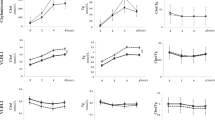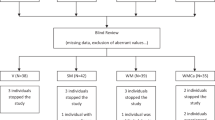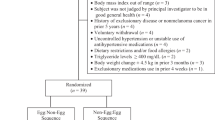Abstract
Background/objectives:
Plant stanol esters lower serum low-density lipoprotein (LDL)-cholesterol (LDL-C), but responses between individuals vary widely. As the ability of subjects to respond to acute dietary challenges may reflect the flexibility to adapt to changes on the longer term, we related subjects' acute postprandial metabolic changes to changes in serum lipoproteins after chronic intake of plant stanol esters.
Subjects/methods:
In a double-blind crossover design, 20 healthy subjects received in random order a high-fat shake enriched with or without plant stanol esters (4 g). Blood samples were taken during 4 h to examine lipid, glucose and lipoprotein profiles. Two subjects dropped out. For the 3 weeks after this postprandial test, the subjects who received the shake with plant stanol esters continued the consumption of plant stanol-enriched (3g/day) margarine and subjects receiving the control shake in the postprandial test consumed for the next 3 weeks a control margarine. After the washout period, subjects received the other shake and margarines.
Results:
The margarine enriched with plant stanol esters lowered concentrations of total cholesterol by 7.3% (P<0.01), LDL-C by 9.5% (P<0.01) and apoB100 by 8.6% (P<0.01). Furthermore, particle concentrations of total very low-density lipoprotein (VLDL), small VLDL and large LDL were reduced by 26.6% (P=0.02), 27.6% (P=0.02) and 12.3% (P=0.04), respectively. Plant stanol esters did not affect parameters related to lipid and glucose metabolism during the postprandial phase. However, the incremental area under the curve (iAUC) of the postprandial glucose concentration after consuming the control shake correlated positively with changes in fasting concentrations of total cholesterol, LDL-C, apoB100, total VLDL, small VLDL and intermediate-density lipoprotein after 3 weeks.
Conclusions:
A single dose of plant stanol esters does not change postprandial lipid and lipoprotein profiles. However, postprandial glucose responses may predict the effects of chronic plant stanol ester consumption.
This is a preview of subscription content, access via your institution
Access options
Subscribe to this journal
Receive 12 print issues and online access
$259.00 per year
only $21.58 per issue
Buy this article
- Purchase on Springer Link
- Instant access to full article PDF
Prices may be subject to local taxes which are calculated during checkout



Similar content being viewed by others
References
Baumgartner S, Mensink RP, Plat J . Plant sterols and stanols in the treatment of dyslipidemia: new insights into targets and mechanisms related to cardiovascular risk. Curr Pharm Des 2011; 17: 922–932.
De Smet E, Mensink RP, Plat J . Effects of plant sterols and stanols on intestinal cholesterol metabolism: suggested mechanisms from past to present. Mol Nutr Food Res 2012; 56: 1058–1072.
Brufau G, Kuipers F, Lin Y, Trautwein EA, Groen AK . A reappraisal of the mechanism by which plant sterols promote neutral sterol loss in mice. PLoS One 2011; 6: e21576.
Rideout TC, Chan YM, Harding SV, Jones PJ . Low and moderate-fat plant sterol fortified soymilk in modulation of plasma lipids and cholesterol kinetics in subjects with normal to high cholesterol concentrations: report on two randomized crossover studies. Lipids Health Dis 2009; 8: 45.
Ottestad I, Ose L, Wennersberg MH, Granlund L, Kirkhus B, Retterstol K . Phytosterol capsules and serum cholesterol in hypercholesterolemia: a randomized controlled trial. Atherosclerosis 2013; 228: 421–425.
Bozzetto L, Annuzzi G, Corte GD, Patti L, Cipriano P, Mangione A et al. Ezetimibe beneficially influences fasting and postprandial triglyceride-rich lipoproteins in type 2 diabetes. Atherosclerosis 2011; 217: 142–148.
Relas H, Gylling H, Miettinen TA . Effect of stanol ester on postabsorptive squalene and retinyl palmitate. Metabolism 2000; 49: 473–478.
van Dijk SJ, Mensink M, Esser D, Feskens EJ, Muller M, Afman LA . Responses to high-fat challenges varying in fat type in subjects with different metabolic risk phenotypes: a randomized trial. PLoS One 2012; 7: e41388.
Friedewald WT, Levy RI, Fredrickson DS . Estimation of the concentration of low-density lipoprotein cholesterol in plasma, without use of the preparative ultracentrifuge. Clin Chem 1972; 18: 499–502.
Freedman DS, Otvos JD, Jeyarajah EJ, Shalaurova I, Cupples LA, Parise H et al. Sex and age differences in lipoprotein subclasses measured by nuclear magnetic resonance spectroscopy: the Framingham Study. Clin Chem 2004; 50: 1189–1200.
Plat J, Mensink RP . Effects of diets enriched with two different plant stanol ester mixtures on plasma ubiquinol-10 and fat-soluble antioxidant concentrations. Metabolism 2001; 50: 520–529.
Matthews JN, Altman DG, Campbell MJ, Royston P . Analysis of serial measurements in medical research. BMJ 1990; 300: 230–235.
Plat J, Mackay D, Baumgartner S, Clifton PM, Gylling H, Jones PJ . Progress and prospective of plant sterol and plant stanol research: report of the Maastricht meeting. Atherosclerosis 2012; 225: 521–533.
Dayspring T . Images, lipoproteins, drugs, and atherothrombotic events. Menopause 2009; 16: 632–634.
Rideout TC, Harding SV, Jones PJ . Consumption of plant sterols reduces plasma and hepatic triglycerides and modulates the expression of lipid regulatory genes and de novo lipogenesis in C57BL/6J mice. Mol Nutr Food Res 2010; 54: S7–13.
Theuwissen E, Plat J, van der Kallen CJ, van Greevenbroek MM, Mensink RP . Plant stanol supplementation decreases serum triacylglycerols in subjects with overt hypertriglyceridemia. Lipids 2009; 44: 1131–1140.
Plat J, Mensink RP . Plant stanol esters lower serum triacylglycerol concentrations via a reduced hepatic VLDL-1 production. Lipids 2009; 44: 1149153.
Strassburg K, Esser D, Vreeken RJ, Hankemeier T, Muller M, van Duynhoven J et al. Postprandial fatty acid specific changes in circulating oxylipins in lean and obese men after high-fat challenge tests. Mol Nutr Food Res 2014; 58: 591–600.
Katan MB, Grundy SM, Jones P, Lau M, Miettinen T, Paoletti R . Efficacy and safety of plant stanols and sterols in the management of blood cholesterol levels. Mayo Clin Proc 2003; 78: 965–978.
Packard CJ, Shepherd J . Lipoprotein heterogeneity and apolipoprotein B metabolism. Arterioscler Thromb Vasc Biol 1997; 17: 3542–3556.
Plat J, Brufau G, Dallinga-Thie GM, Dasselaar M, Mensink RP . A plant stanol yogurt drink alone or combined with a low-dose statin lowers serum triacylglycerol and non-HDL cholesterol in metabolic syndrome patients. J Nutr 2009; 139: 1143–1149.
Berge KE, von Bergmann K, Lutjohann D, Guerra R, Grundy SM, Hobbs HH et al. Heritability of plasma noncholesterol sterols and relationship to DNA sequence polymorphism in ABCG5 and ABCG8. J Lipid Res 2002; 43: 486–494.
Rideout TC, Harding SV, Mackay DS . Metabolic and genetic factors modulating subject specific LDL-C responses to plant sterol therapy. Can J Physiol Pharmacol 2012; 90: 509–514.
Thuluva SC, Igel M, Giesa U, Lutjohann D, Sudhop T, von Bergmann K . Ratio of lathosterol to campesterol in serum predicts the cholesterol-lowering effect of sitostanol-supplemented margarine. Int J Clin Pharmacol Ther 2005; 43: 305–310.
Demonty I, Ras RT, van der Knaap HC, Duchateau GS, Meijer L, Zock PL et al. Continuous dose-response relationship of the LDL-cholesterol-lowering effect of phytosterol intake. J Nutr 2009; 139: 271–284.
Watts GF, Chan DC, Ooi EM, Nestel PJ, Beilin LJ, Barrett PH . Fish oils, phytosterols and weight loss in the regulation of lipoprotein transport in the metabolic syndrome: lessons from stable isotope tracer studies. Clin Exp Pharmacol Physiol 2006; 33: 877–882.
Paramsothy P, Knopp RH, Kahn SE, Retzlaff BM, Fish B, Ma L et al. Plasma sterol evidence for decreased absorption and increased synthesis of cholesterol in insulin resistance and obesity. Am J Clin Nutr 2011; 94: 1182–1188.
Hernandez-Mijares A, Banuls C, Jover A, Sola E, Bellod L, Martinez-Triguero ML et al. Low intestinal cholesterol absorption is associated with a reduced efficacy of phytosterol esters as hypolipemic agents in patients with metabolic syndrome. Clin Nutr 2011; 30: 604–609.
Gylling H, Hallikainen M, Simonen P, Miettinen HE, Nissinen MJ, Miettinen TA . Serum and lipoprotein sitostanol and non-cholesterol sterols after an acute dose of plant stanol ester on its long-term consumption. Eur J Nutr 2012; 51: 615–622.
Acknowledgements
We thank all study participants for their cooperation and enthusiasm. We also thank the technical and dietary staff from our department for their support. We thank Anja Kerksiek for the analysis of the plant sterols, stanols and cholesterol precursors. ED, RPM and JP designed the research; ED conducted the research; ED, RPM and JP analyzed the data; ED, RPM Dl and JP wrote the paper; and JP had primary responsibility for final content. All authors read and approved the final manuscript. The study was financially supported by Raisio, Finland.
Author information
Authors and Affiliations
Corresponding author
Ethics declarations
Competing interests
The authors declare no conflict of interest.
Additional information
Supplementary Information accompanies this paper on European Journal of Clinical Nutrition website
Supplementary information
Rights and permissions
About this article
Cite this article
De Smet, E., Mensink, R., Lütjohann, D. et al. Acute effects of plant stanol esters on postprandial metabolism and its relation with changes in serum lipids after chronic intake. Eur J Clin Nutr 69, 127–133 (2015). https://doi.org/10.1038/ejcn.2014.200
Received:
Revised:
Accepted:
Published:
Issue Date:
DOI: https://doi.org/10.1038/ejcn.2014.200



